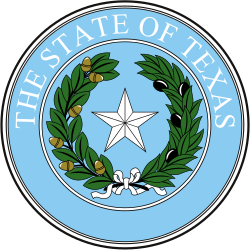| |||||||||||||||||
| Turnout | 70.3% | ||||||||||||||||
|---|---|---|---|---|---|---|---|---|---|---|---|---|---|---|---|---|---|
| |||||||||||||||||
 County results[a] Ferguson: 50–60% 60–70% 70–80% 80–90% >90% Bullington: 50–60% 60–70% 70–80% Tie: Not Reported: | |||||||||||||||||
| |||||||||||||||||
| Elections in Texas |
|---|
 |
|
|
The 1932 Texas gubernatorial election was held on November 8, 1932, to elect the Governor of Texas. Democratic nominee and former Governor of Texas Miriam A. Ferguson defeated Republican nominee Orville Bullington.[2]
The Democratic primary election was held on July 23, 1932. As no candidate won a majority of votes, there was a run-off on August 27, 1932, between the two highest ranking candidates former Governor of Texas Miriam A. Ferguson and incumbent Governor of Texas Ross S. Sterling. Ferguson would eventually win the primary with 50.20% against Sterling, which marked the closest primary defeat for an incumbent governor in United States history.[3]

| Party | Candidate | Votes | % | |
|---|---|---|---|---|
| Democratic | Miriam A. Ferguson | 402,238 | 41.56% | |
| Democratic | Ross S. Sterling (incumbent) | 296,383 | 30.62% | |
| Democratic | Tom F. Hunter | 220,391 | 22.77% | |
| Democratic | M. H. Wolfe | 32,241 | 3.33% | |
| Democratic | George W. Armstrong | 5,312 | 0.55% | |
| Democratic | Roger Q. Evans | 3,974 | 0.41% | |
| Democratic | Frank Putnam | 2,962 | 0.31% | |
| Democratic | C. A. Frakes | 2,338 | 0.24% | |
| Democratic | J. Ed Glenn | 2,089 | 0.22% | |
| Total votes | 967,928 | 100.0% | ||

| Party | Candidate | Votes | % | |
|---|---|---|---|---|
| Democratic | Miriam A. Ferguson | 477,644 | 50.20% | |
| Democratic | Ross S. Sterling (incumbent) | 473,846 | 49.80% | |
| Total votes | 951,490 | 100.0% | ||
The Republican convention was held on August 9, 1932. In the months leading up to the convention, John F. Grant was seen as the likely nominee. In the days before the convention, a movement to nominate Orville Bullington began to grow. Bullington had not sought the party's nomination, but party leaders thought that he was their strongest candidate and backed him regardless.[12]
During the convention, Grant withdrew his candidacy and Bullington was nominated unanimously. In his convention speech, Bullington came out strongly in favor of prohibition and pledged to uphold the Eighteenth Amendment. Bullington's nomination temporarily divided the party, and R. B. Creager threatened to back Grant if he opposed Bullington. Grant, however, chose not to challenge Bullington, thus avoiding a split.[14][15][16]
Similar to her 1924 campaign, Ferguson's candidacy saw a large number of defections.[18] After his lawsuit to keep Ferguson off of the ballot failed,[19] Democratic incumbent Ross Sterling crossed party lines to endorse Orville Bullington.[20]
On election day, November 8, 1932, Democratic nominee Miriam A. Ferguson won re-election by a margin of 204,805 votes over Bullington, thereby retaining Democratic control over the office of Governor. By contrast, Franklin D. Roosevelt defeated Herbert Hoover by a margin of 662,389 votes in the concurrent presidential election.[21] Ferguson was sworn in as the 32nd Governor of Texas on January 17, 1933.[22]
| Party | Candidate | Votes | % | |
|---|---|---|---|---|
| Democratic | Miriam A. Ferguson | 522,395 | 61.98% | |
| Republican | Orville Bullington | 317,590 | 37.68% | |
| Socialist | George Clifton Edwards | 1,873 | 0.22% | |
| Independent Democratic | George W. Armstrong | 768 | 0.09% | |
| Communist | Philip L. Howe | 138 | 0.02% | |
| Liberty | Otho L. Heitt | 134 | 0.09% | |
| Total votes | 843,898 | 100.00% | ||
| Democratic hold | ||||
editors
This is the start of the #editors chat. #editors is a chat channel to discuss collecting and organizing hub content.